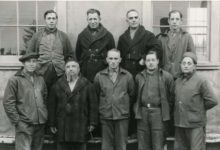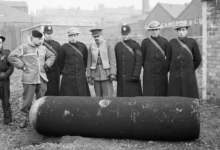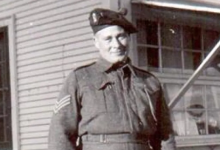Honouring the Arctic’s last known WW II bone collector
In late May 1940, 20-year-old Qapik Attagutsiak voluntarily picked up a burlap bag, put her one-year-old son in her amauti — a traditional caribou parka with a built-in baby pouch — and set off on a grim search.
The new mom went out to the walrus harvesting grounds of her spring hunting camp in Qaipsunik, an island near Igloolik in what is now Nunavut, to fill her sack with animal bones to secretly ship down south.
Qapik, who goes by her first name, and other adult members of the camp collected carcasses of walrus, seals and even dogs. The bones were bloody and some still had meat on them crawling with maggots. Regardless, they filled up approximately three bags per day for a full week. They continued that work throughout the war.
The byproducts were brought to industrial ports, such a Montreal and Halifax, then processed at rendering plants into cordite for ammunition, aircraft glue and fertilizer to help the Allies fight an ocean away.
“They did what was important for the elders when they asked them [young people] that you guys have to be collecting bones,” said Kataissee Attagutsiak, her daughter who translates her story from Inuktitut into English. “They did it without thought.”
Now, nearly 75 years since her efforts helped in the march toward victory and the end of the Second World War, Qapik’s lesson in selflessness is being recognized.
The Inuk elder is being honoured on Monday by Parks Canada, in partnership with the Canadian Armed Forces and the Canadian War Museum, during a celebration at the Canadian Museum of History in Gatineau, Que., as a representative of the Inuit wartime contributions.
Qapik is the last known living person from the Arctic to have participated in the bone collection drive of the 1940s, according to Parks Canada.
If parachutes appeared, they should ‘shoot to kill’
At age 99, Qapik, who now lives in Arctic Bay, can still vividly recall how she and other Inuit felt when they heard from the local Catholic priest about the Second World War.
“It was scary for them,” said Kataissee, who sits beside her mom in a downtown Ottawa hotel room.
Even though she was far away from the battles in Europe, Qapik said the Inuit were told by missionaries to get ready for a fight of their own.
“They warned them that the parachutes, the big airplanes, might be coming in your area,” Kataisee said.
“So if the planes are coming in and there’s a parachute coming out, jumping out of the airplane, you have to shoot to kill because they might be killing you.”
If watching the sky for enemies wasn’t enough to worry about, Qapik said many dogs, who the Inuit relied on for transportation, were dying of unknown causes.
Qapik said the Inuit sprang into action when the federal government launched the National Salvage Campaign to help the war effort.
Raw materials had become scarce during the First World War.
To avoid that happening again, Parliament passed the Department of Munitions and Supply Act in 1939 to centralize and co-ordinate sourcing of resources and industrial production. The Department of National War Services encouraged Canadians to gather rags, rubber, paper, metals, fats and bones, which could be recycled into essential war materials.
It was a tough job, but a necessary one, according to Parks Canada researcher Ray Coutu.
“It was not very pleasant work picking up carcasses that were rancid, very smelly,” Coutu said.
“They didn’t even think about compensation. Inuit are people who help each other and for them this was normal for them to contribute in their own way.”
Story told for first time in 80 years
Coutu is part of a three-person research team that worked with Qapik over the last two years to document her story for the first time.
“This specific story really struck me personally,” Coutu said.
“This happened 79, 80 years ago and people haven’t heard about it, so we’re quite happy that this elder who hadn’t even talked about this to her own children has come forward to allow us to help her tell her story for future generations.”
Qapik said one of the greatest pieces of news she’s ever heard was when the war ended.
“They were so proud,” Kataissee said.
“They were so excited when they heard that the war had ended that now they can live until the full end of their lives, so it’s not going to be disruptive.”
Qapik carried on with her life as a seamstress and midwife, saving several babies and moms.
She is joining a list of more than 140 Canadians who have been recognized by Parks Canada for their endeavours during the First and/or Second World War, as Hometown Heroes.
While Qapik is humbled, she refused to be acknowledged individually. Qapik insisted on representing all of the Nunavut Inuit for their efforts during the Second World War.
As she prepares to turn 100 in June, Qapik is reflecting on the lessons the next generation can take from her Second World War experience.
“The only way you can give peace is to help each other and understand what your responsibilities are,” Kataisee said.
“To be giving peace starts from you.”
CBC








Redes Sociais - Comentários